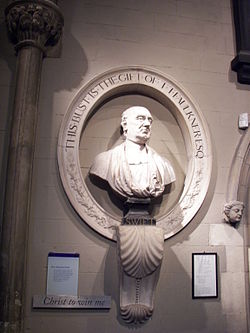The following have served as deans (where they are known to have previously held office at the cathedral, this is noted):
Post-Reformation to Disestablishment
The Reformation took effect in Ireland following a hiatus in the office of Archbishop of Dublin after the death of Archbishop Alen in 1534, and the election of George Browne to that office by the Chapters of both Cathedrals under pressure from King Henry VIII.
- 1537–1547 – Edward Bassenet, a sitting prebendary, for whose election pressure was exerted by the State, Archbishop George Browne writing to the King that the Chapter had elected him "only in respect of your Grace's desire"
From 1547 to 1555, St. Patrick's was suppressed as a Foundation, reduced to the status of a parish church, without its Chapter or Dean – the Dean and other senior officials being pensioned off by the King. It was restored in 1555.
- 1555–1560 – Thomas Leverous, appointed by Queen Mary, formerly tutor to the powerful FitzGerald family; became Bishop of Kildare, and was one of the two Irish Bishops to refuse to take the Oath of Supremacy, after which he was deprived of both offices and ran a school in Adare
- 1560–1565 – Alexander Craike, Prebendary of Clonmethan; (also Bishop of Kildare)
- 1565–1567 – Adam Loftus, also Archbishop of Armagh, then resigned to become Archbishop of Dublin; later first Provost of Trinity College Dublin; died 1605
- 1567–1573 – Robert Weston (a layman, also Lord Chancellor of Ireland 1567–1573 and Dean of Wells 1570–1573)
- 1573–1581 – Sir William Gerard, a layman who was also Lord Chancellor of Ireland 1576–1581 (a contemporary wrote that he "confessed how greatly he had been tormented in conscience with keeping the deanery", but never relinquished it.)
- 1581–1585 – Thomas Jones, Chancellor; afterwards Bishop of Meath 1584 and then Archbishop of Dublin
- 1585–1597 – Richard Meredyth, (appointed Bishop of Leighlin 1589, with deanery in commendam)
- 1597–1608 – John Ryder, who became Bishop of Killaloe
- 1608–1625 – Thomas Moigne, Prebendary of Monmohenock; (appointed Bishop of Kilmore and Ardagh 1620, with deanery in commendam)
- 1625–1649 – Benjamin Culme (d.1657), of Molland-Champson and Canonsleigh, Devon, Prebendary of Mulhuddart
1649–1660 – office vacant during the period of Parliamentary governance; a Robert Chambers was appointed "Reader at St. Patrick's" following Dean Culme's retirement
- 1660–1666 – William Fuller, who became Bishop of Limerick 1663 and later of Bishop of Lincoln, and who composed an anthem for the Restoration in Ireland, celebrated on 27 January 1660 with the consecration at the cathedral of twelve bishops
- 1666–1675 – Thomas Seele, Chancellor; Fellow, and later Provost of Trinity College Dublin
- 1675–1678 – Benjamin Parry, Prebendary of Castleknock (became Bishop of Ossory 1677 with deanery in commendam)
- 1678–1689 – John Worth, Chancellor, previously Dean of Kildare
- 1689–1691 – William King, Chancellor, became Bishop of Derry 1691, later Archbishop of Dublin, Lord Justice; (1650–1729)
- 1691–1694 – Michael Jephson, previously Chancellor of Christ Church Cathedral
- 1694–1696 – Thomas Lindsay, became Bishop of Killaloe, Bishop of Raphoe, and then Archbishop of Armagh
- 1696–1699 – Edward Smyth, Fellow of Trinity College Dublin and Chaplain to King William III; became Vice-Chancellor of the University of Dublin and later Bishop of Down and Connor
- 1699–1705 – Jerome Ryves, previously Chancellor of Christ Church Cathedral
- 1705–1713 – John Sterne, Chancellor, rebuilt Dean's house in 1713; became Bishop of Dromore, and later of Clogher, and appointed Vice-Chancellor of the University of Dublin in 1721
- 1713–1745 – Jonathan Swift, Prebendary of Dunlavin; the famous writer
- 1745–1746 – Gabriel James Maturin, Prebendary of Mulhuddart; previously Dean of Kildare
- 1746–1775 – Francis Corbet, Treasurer
- 1775–1794 – William Cradock, Prebendary of St. Audoen's
- 1794– Robert Fowler later (1813), Bishop of Ossory
- 1794–1810 – James Verschoyle, previously a Minor Canon, Vicar-Choral, Prebendary, Archdeacon of Glendalough and Precentor; later, Bishop of Killala and Achonry, 1810
- 1810–1818 – John William Keatinge, last Chaplain to the Irish House of Commons
- 1818–1828 – Richard Ponsonby, Precentor; later Bishop of Killaloe, 1828 then Bishop of Derry
- 1828–1842 – Henry Richard Dawson, oversaw both some renovation of the building and reorganisation of worship
- 1842–1842 – Robert Daly, Prebendary of Stagonil; election subsequently contested; later Bishop of Cashel and Waterford
- 1843–1864 – Henry Pakenham
Note that from 1846 to 1872, the office of Dean of Christ Church was united to that of Dean of St. Patrick's.

